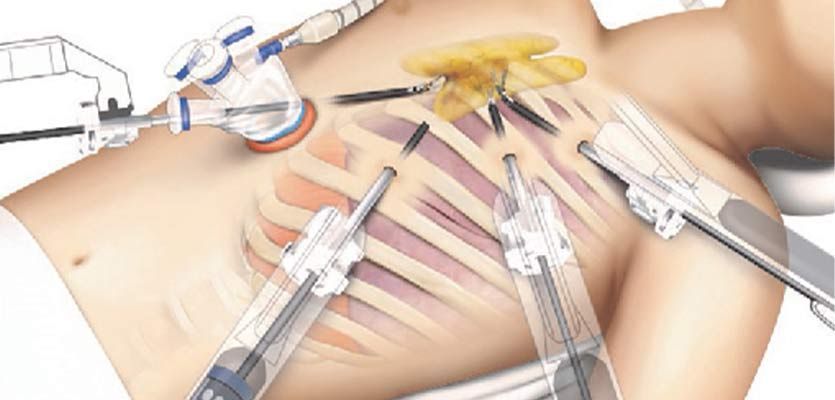Mediastinal Surgery and Thymus Surgery

Surgery is a primary treatment for thymic mass, especially in the disease’s early stages.
Treatment goals for surgery are to:
- Eliminate as much of the tumor as possible by removing the tumor and a margin of healthy tissue
- Relieve symptoms of advanced cancer that has spread (metastasized) to other parts of the body.
Main approaches in the management of the thymic tumors and anterior mediastinal masses are:
Sternotomy/thymectomy
Sternotomy is the most common surgery used to treat thymomas. In a sternotomy, we make a vertical incision through the breastbone to reach the front of the mediastinum. Since no chest wall muscles are included in the incision, pain and recovery time after the operation is usually limited.
Video-Assisted Thoracic Surgery (VATS) Thymectomy
This approach allows us to remove small thymomas with the same operation within the chest that is performed by thymectomy, but it is done through three to four small incisions rather than the large incision that a sternotomy entails. We gain a view inside the chest from a small video camera inserted through one of the small incisions, and the procedure is carried out with long instruments passed through the other small incisions. Patients who have undergone VATS sternotomy have less pain and recover faster from surgery.
Robotic Thymectomy (RATS)
Robotic thymectomy is done with small incisions similar to VATS thymectomy, but with perhaps a bit more maneuverability of the operating instruments. The surgical instruments extend from the arms of the robot. The arms are guided by your surgeon from a bedside console that allows the surgeon to visualize the inside of your chest and guide the robotic movements with his/her own hands. Postoperative discomfort and recovery should be similar to after VATS thymectomy.
Thoracotomy
In a thoracotomy, we reach your mediastinum by making an incision on your back or on your side, or sometimes between your ribs. After a thoracotomy, most people stay in the hospital for about 3 to 4 days.
Risks of surgery for a thymic mass
An operation for a thymic mass is a significant surgery. People commonly experience pain and shortness of breath after surgery. Weakness and fatigue may linger for weeks.
Complications following mediastinal surgery can include:\
- Reactions to anesthesia
- Bleeding
- Blood clots in the legs or lungs
- Pneumonia
- Hematoma: This is when the surgery site fills up with blood and there is a sudden onset of swelling and pain. This is a complication that requires urgent medical intervention.
- Infection: Signs of infection include a fever, chills, nausea, vomiting, pain at the incision site, or discomfort that medicine does not control.
- Phrenic nerve injury: The nerve to the muscle that supplies your breathing muscle, the diaphragm" to the list of complications.

